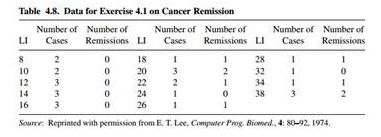Reference no: EM131038491
Problem 4.1 with Table 4.8 used a labeling index (LI) to predict π = the probability of remission in cancer patients.
When the data for the 27 subjects are 14 binomial observations (for the 14 distinct levels of LI), the deviance for this model is 15.7 with df = 12. Is it appropriate to use this to check the fit of the model? Why or why not? b. The model that also has a quadratic term for LI has deviance = 11.8. Conduct a test comparing the two models. c. The model in (b) has fit, logit() = -13.096 + 0.9625(LI) - 0.0160(LI)2, with SE = 0.0095 for 2 = -0.0160. If you know basic calculus, explain why is increasing for LI between 0 and 30. Since LI varies between 8 and 38 in this sample, the estimated effect of LI is positive over most of its observed values. d. For the model with only the linear term, the Hosmer-Lemeshow test statistic = 6.6 with df = 6. Interpret.
Problem 4.1 A study used logistic regression to determine characteristics associated with Y = whether a cancer patient achieved remission (1 = yes). The most important explanatory variable was a labeling index (LI) that measures proliferative activity of cells after a patient receives an injection of tritiated thymidine. It represents the percentage of cells that are "labeled." Table 4.8 shows the grouped data. Software reports Table 4.9 for a logistic regression model using LI to predict π = P(Y = 1).
a. Show how software obtained πˆ = 0.068 when LI = 8.
b. Show that = 0.50 when LI = 26.0.
c. Show that the rate of change in is 0.009 when LI = 8 and is 0.036 when LI = 26.
d. The lower quartile and upper quartile for LI are 14 and 28. Show that πˆ increases by 0.42, from 0.15 to 0.57, between those values.
e. When LI increases by 1, show the estimated odds of remission multiply by 1.16.
